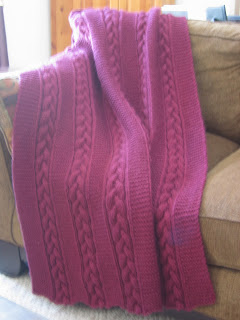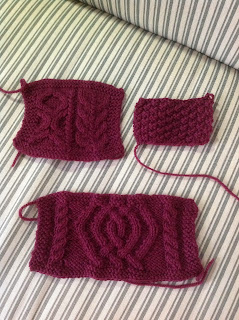When I began this incredible fiber arts journey I have been taking over 20 years ago, it was
crochet that started it all. I had learned to crochet from my great grandmother, or as everyone called her, "Mum Jo." She was one in a line of talented stitchers, going back at least as far as her own mother. I am fortunate to have a few of their works in my possession, including crocheted afghans, dollies, table clothes, and a piece of knitted garter stitch cloth. Mum Jo's daughter, my grandmother, was also a very talented seamstress.
Given how much the needle arts was a part of the lives of the women in my ancestry, it is surprising how little of a role they played in my childhood. I learned latch-hook rug making as many kids do (but never finished a project), learned to sew a button from my grandmother, and later took a sewing class. None of these pursuits really made much impact on my day-to-day life as a child, though. In fact, I remember reading, drawing, and swimming being my primary interests. Luckily, though, Mum Jo took me aside one summer day when I was visiting her and introduced me to crochet. She gave me some homely tan, acrylic yarn and a crochet hook. She taught me to make a foundation chain and to single crochet. She may have taught me double crochet, too, but I can't remember that. All I know is that I worked on a single crochet ripple "afghan" for awhile, but only ended up with less than five inches completed. It then sat in my closet on a shelf for over 10 years.
Every time I would go home to visit my parents, I would peek into my old closet and see that crochet. I often regretted giving it up and wondered if I could start again, but by that time, Mum Jo was in her 90s and had given up crochet long ago. I didn't know who to ask for help, yet the crochet kept calling me. Finally, during a visit home in my early 20s, I decided to bring the crochet back with me and to ask a colleague to help me get started again. She was a talented quilter, but I knew she also crocheted a bit. She got me going on single crochet again, and then I bought a pamphlet from a craft store to learn the rest. I caught on quickly, and before I knew it, I was hooked! Many late nights were spent pondering over stitch patterns, planning afghans, and finally crocheting them. Not long after that, a friend introduced me to knitting, and eventually when I got the hang of it, my crochet took a far back seat. However, I always enjoyed it, and lately it has been calling to me again -- mostly due to a blog I found that really inspired me:
Attic24. Lucy's glorious colors and inviting afghans caught my attention and have held my attention for awhile now. Lately, I decided to begin one of her
Granny Stripe Blankets, using an assortment of
Vanna's Choice colors that I had accumulated for an abandoned granny square afghan. I am so pleased with the way this afghan is taking shape and am enjoying choosing the color combinations very much. Here is the work in progress:
And a close up to illustrate the color combinations:
My plan is to edge the afghan in a way that predominately highlights the blue since the room I am making it for is decorated with blue accents. We have a red trunk/coffee table in the room, too, hence the red stripe running through the afghan every so often. The couch is a tan color, which ties in well with the earth tones in the blanket. This project has brought me more confidence in my sense of color and has inspired me to look at ways of using color combining more in both my knitting and crochet.
After being bitten by the crochet bug again, I decided to whip up a quick hat as a Christmas gift for my neighbor's new baby girl. They had generously brought us homemade pumpkin roll for the holidays, and not being a baker myself, I had been wondering how I could return the gesture. Crocheting an adorable hat seemed like just the thing!
If any of you have thought about trying crochet, I encourage it since it compliments knitting well. From a practical standpoint, crochet can be used to make a great provisional cast-on or to secure steeks in stranded knitting. It can also be used to make
practical or
pretty edges. I have also found that there are times when taking a break from one repetitive motion to work in a completely different repetitive mode really helps me to prevent the onset of tendonitis. This is especially true since I predominately knit using
English style (right-hand yarn hold) and crochet in the traditional left-hand yarn-hold manner. Even though, I sometimes switch to
Continental Style knitting (left-hand yarn hold) to relieve repetitive stress, crochet feels even more natural to me and is, therefore, great for mindless stitching in the evenings. I have gotten more proficient at Continental style knitting through practice, but it is nowhere near as effortless for me as English style knitting or crocheting is, having done both of these needle work techniques for over 20 years.
Knitting will always be my greatest passion, but it is fun having other fiber arts calling my name, and crochet is definitely one that will steal my attention from time to time!

















.jpg)
.jpg)
.jpg)
.jpg)







